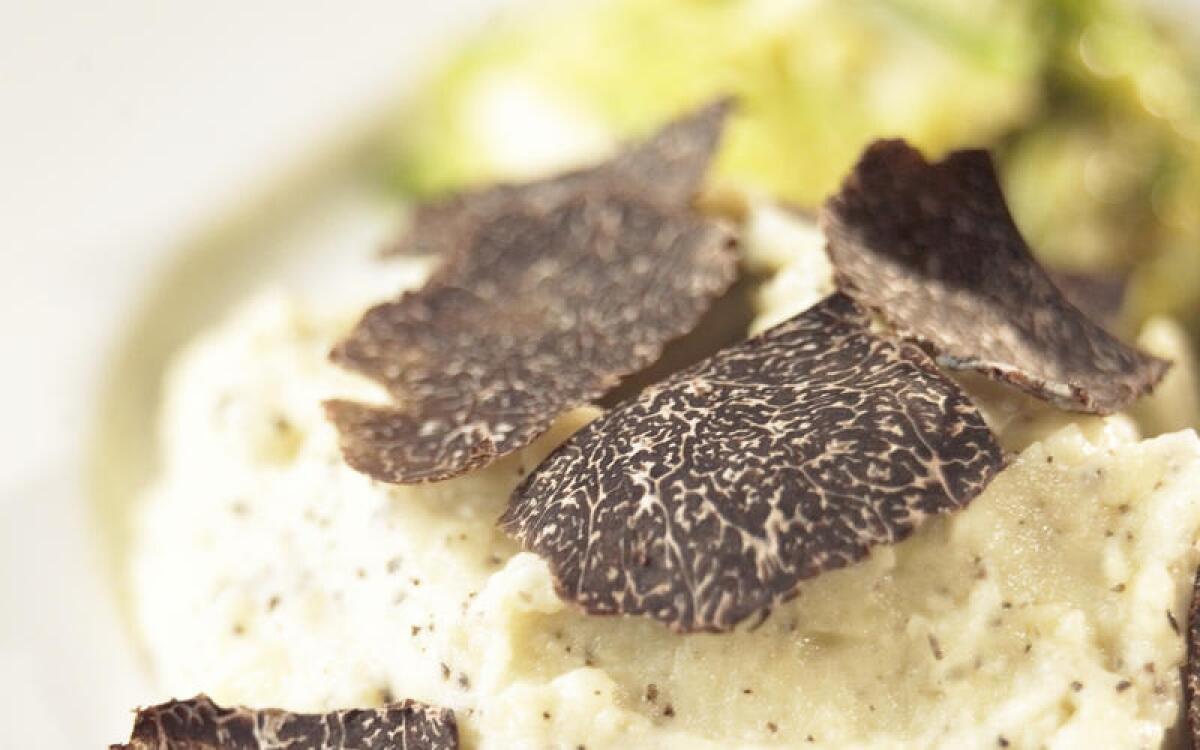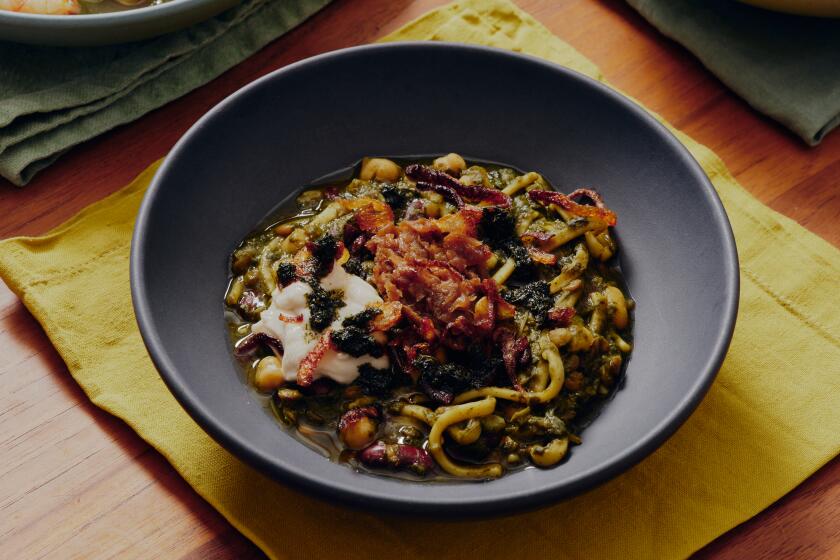Luxurious potato puree

- Share via
Some people mash and others smash, some choose to whip and others pass (through a tamis, that is -- the drum sieve used in professional kitchens). And yes, the food mill has its devoted fans. But the easiest way to super-velvety potato puree has to be the ricer.
It’s one of the silliest looking tools, much like a giant garlic press. Put in the boiled potato, squeeze with all your might, and out come squiggles of perfect puree.
It’s the “squeeze with all your might” part that’s the problem with most ricers. After the potato goes in the chamber, the levers are about a mile apart, so you grab one handle with each hand and use the power of both biceps to start to squeeze the tuber through. Then you switch to one hand to squeeze the handles together. Woe to those with small hands, or to those who have undercooked the potato.
Finally, there’s a ricer that doesn’t require tremendous muscle power. It won’t win any prizes for its good looks, but the new potato ricer from the Swiss company Kuhn Rikon has the smartest design of any ricer I’ve tried. It’s made of molded plastic, of a heavier gauge than the flimsy model I’ve been using for a decade, and it has a chamber large enough to hold a pretty big Yukon gold.
It comes with two discs -- one for fine, the other for coarser puree -- and there’s a clever built-in compartment to hold the disc you’re not using (so you don’t lose it). Best of all, it’s ergonomically superior to any ricer I’ve tried -- by a long shot. And I’ve tried a lot of them.
Somehow, though, I had never put the Oxo Good Grips potato ricer to the test. The U.S. gadget firm usually aces kitchen tool design, so I staged a mash-off.
The Oxo disappointed sorely. Made from a single piece of stainless steel, it’s much more attractive than its Swiss challenger, but that also means only one fineness of puree. (I didn’t take points off for that, because to my mind, finer puree is always better. I’m sure there’s a use for a coarser one, but I can’t think of what that could be. OK -- here’s one: homemade baby food, for the time when teeth start to come in.)
But weirdly, although the ricer does have the Good Grips rubbery black stuff on the two handles, that doesn’t do you any good until they’re squeezed almost shut. Also, the handles’ inner edges are almost sharp -- they hurt my hands as I squeezed.
And ergonomically, the stick-straight handles aren’t nearly as user friendly as Kuhn Rikon’s gently curved plastic handles.
Not only was the Swiss model more comfortable to hold, it required noticeably less force.
So we have the ricer of the century (so far, anyway). And just in time to make the most luxurious mashed potatoes imaginable, perfect for Christmas dinner. It’s a dish based on the potato puree that helped make French chef Joel Robuchon famous in the early 1980s.
Robuchon’s recipe, as it appeared in the 1991 book “Simply French” by Patricia Wells, called for a whole stick of butter per pound of potatoes. But, Wells wrote, “For exceptionally rich potatoes, the quantity of butter may be doubled.”
I don’t think you need anywhere near that much butter for a puree that’s very rich and delicious; the recipe that follows calls for half that amount. But I’ve substituted half-and-half for the milk (Christmas comes but once a year).
Oh, and I’ve added a generous amount of truffles. Black winter truffles from France have just come into season, and each week they’re better and better. (They’ll be in season until March.)
The trick with black truffles is to get them fresh -- from a good source -- otherwise they’re flat and flavorless, not at all worth the small fortune they cost.
Use any extra to make more truffle butter than the recipe calls for -- that’s the best way to preserve the flavor, and you can stir it into pasta or lentils or soft-scrambled eggs for something truly wonderful.
Robuchon’s recipe called for putting potatoes through a food mill, stirring them vigorously to dry, then vigorously stirring in the butter bit by bit, slowly adding in the hot milk, stirring vigorously again, then passing the mixture through a tamis. And finally, no joke here, stirring vigorously again. I tried that and got something a bit gluey.
So this recipe just goes for ease -- a well-designed ricer, a little easy stirring. And at the table, a flurry of more black truffle shaved on top.
Now that’s luxurious.
One or two days before you want to serve the potatoes, make truffle butter. Use a vegetable peeler or sharp paring knife to peel part of the truffle, then mince about half of it, and measure it. You want 3 tablespoons. If you don’t have enough, mince a little more. Store the rest of the truffle until needed. Combine the truffle and the butter, mixing thoroughly, then roll it into a log in plastic wrap and refrigerate at least overnight.
Scrub but don’t peel the potatoes. Place them in a large saucepan, cover them with water by about an inch and add enough salt to the water to make it taste like the sea. Bring the water to a boil, then reduce heat to medium and cook the potatoes on a low boil until they’re just tender when pierced with a knife, about 20 to 30 minutes. Bring the half-and-half to a simmer in a small pan over medium-high heat; once it simmers, turn the heat to very low.
Drain the potatoes and set aside to cool a little. Cut the cold truffle butter in small pieces. When the potatoes are cool enough to handle, peel them. Clean the pan, place it over low heat, and put the potatoes through a potato ricer into the pan. Add half of the hot half-and-half and stir, then add the butter a few pieces at a time, stirring to incorporate. Add additional half-and-half in stages with the butter, alternating as each is incorporated to achieve the desired consistency. Season to taste with additional salt. Serve immediately, shaving more truffle over each diner’s portion at the table.
Get our Cooking newsletter
Get a taste of Los Angeles — and the world — with recipes and kitchen tricks from the L.A. Times’ Cooking newsletter.
You may occasionally receive promotional content from the Los Angeles Times.















